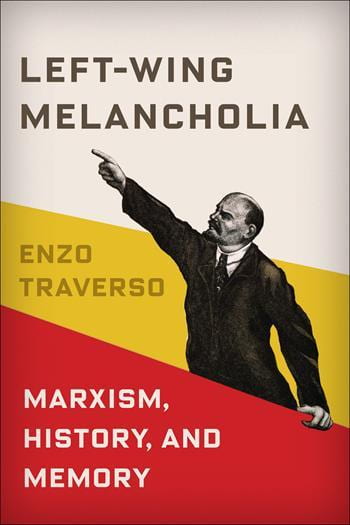by contributing editor Disha Karnad Jani
 In Enzo Traverso’s Left-Wing Melancholia: Marxism, History, and Memory, timing is everything. The author moves seamlessly between such subjects as Goodbye Lenin, Gustave Courbet’s The Trout, Marx’s Eighteenth Brumaire, and the apparently missed connection between Theodor Adorno and C.L.R. James to guide the reader through the topography of the Left in the twentieth century. The book is an investigation of left-wing culture through some of its most prominent (and dissonant) participants, alongside the images and metaphors that constituted the left of the twentieth century as a “combination of theories and experiences, ideas and feelings, passions and utopias” (xiii). By defining the left not in terms of those political parties to be found on the left of the spectrum, and rather gathering his subjects in ontological terms, Traverso prepares the laboratory prior to his investigation, but not through a process of sterilization. Rather, the narrative of the “melancholic dimension” of the last century’s left-wing seems assembled almost by intuition, as we follow along with affinities and synchronicities across the decades. In its simultaneously historical, theoretical, and programmatic ambitions, Left-Wing Melancholia sits in the overlapping space between the boundaries of intellectual history and critical theory.
In Enzo Traverso’s Left-Wing Melancholia: Marxism, History, and Memory, timing is everything. The author moves seamlessly between such subjects as Goodbye Lenin, Gustave Courbet’s The Trout, Marx’s Eighteenth Brumaire, and the apparently missed connection between Theodor Adorno and C.L.R. James to guide the reader through the topography of the Left in the twentieth century. The book is an investigation of left-wing culture through some of its most prominent (and dissonant) participants, alongside the images and metaphors that constituted the left of the twentieth century as a “combination of theories and experiences, ideas and feelings, passions and utopias” (xiii). By defining the left not in terms of those political parties to be found on the left of the spectrum, and rather gathering his subjects in ontological terms, Traverso prepares the laboratory prior to his investigation, but not through a process of sterilization. Rather, the narrative of the “melancholic dimension” of the last century’s left-wing seems assembled almost by intuition, as we follow along with affinities and synchronicities across the decades. In its simultaneously historical, theoretical, and programmatic ambitions, Left-Wing Melancholia sits in the overlapping space between the boundaries of intellectual history and critical theory.
In a series of essays, Traverso explores the left’s expressive modes and missed opportunities: the first half of the book is an exploration of Marxism and memory studies (one dissolved as the other emerged), the melancholic in art and film, and the revolutionary image of Bohemia. The second half of the book is a series of intellectual and personal meetings, which Traverso adjudicates for their usefulness to the left: Theodor Adorno and C.L.R. James’ abortive friendship, Adorno and Walter Benjamin’s correspondence, and Daniel Bensaïd’s work on Benjamin. The “left-wing culture” these affinities is meant to trace is defined as the space carved out by “movements that struggled to change the world by putting the principle of equality at the center of their agenda” (xiii). Since that landscape is rather vast, Traverso relies on resonant juxtaposition and very real exchanges in order to erect monuments to the melancholia he reads throughout their shared projects.
The nineteenth and twentieth centuries burst forth onto the stage of history buoyed by the French and Russian Revolutions, surging confidently forwards into a future tinged with utopia. In devastating contrast, the twenty-first century met a future foreclosed to the possibility of imagining a world outside of triumphant capitalism and post-totalitarian, neoliberal humanitarianism. While successive defeats served to consolidate the ideas of socialism in the past, the defeat suffered by the left in 1989 withheld from memory (and therefore from history) any redemptive lesson. In Left-Wing Melancholia, the reader is thus led gently through the rubble of the emancipatory project of the last two hundred years, and invited to ruminate on what could come of “a world burdened with its past, without a visible future” (18).
As critical theory, Left-Wing Melancholia uses the history of socialism and Marxism over the last two hundred years and its defeat in 1989 in order to name the problem of the left today. As intellectual history, it may be found wanting, at least if one seeks in its tracing of left-wing culture some semblance of linearity. If, however, a reader is willing to follow, instead of context à la Skinner, or concept à la Koselleck, a feeling – then Left-Wing Melancholia will soothe, disturb, and offer an alternative: Traverso assures us that “the utopias of the twenty-first century still have to be invented” (119). Indeed, Traverso argues that Bensaïd “rediscovered a Marx for whom ‘revolutions never run on time’ and the hidden tradition of a historical materialism à contretemps, that is, as a theory of nonsynchronous times or non-contemporaneity” (217). Traverso’s own project could be read as part of this now-unearthed tradition.
It is clear that Traverso is aware of the reconfiguration of enshrined histories of socialism and Marxism implicit here, that he has skewed any orthodox narrative by reading through disparate political projects the feeling of melancholia. Ascribing a single ontology to the left over the course of the twentieth century and representing its culture in such a frenetic fashion makes this book vulnerable to the criticism of the empiricist. For instance, he speculates on the lost opportunity of Adorno’s and James’s friendship with “counterfactual intellectual history”: “what could have produced a fruitful, rather than missed encounter between Adorno and James…between the first generation of critical theory and Black Marxism? It probably would have changed the culture of the New Left and that of Third Worldism” (176). In such statements, it is startling to see at work the faith Traverso has in the dialogue between intellectuals, and in intellectuals’ power to change the course of history.

Hammering through the Berlin Wall. Photograph by Alexandra Avakian, from Smithsonian Mag.
He also eschews the Freudian use of the term “melancholia,” representing it instead as a feeling of loss and impossibility, expressed through writing, monuments, art, film, and his repeated articulations of how “we” felt after 1989. Presumably, this “we” is those of us who existed in a world that contained the Berlin Wall, and then witnessed it come down and had to take stock afterwards. This “we” is transgenerational, as it is also the subject that “discovered that revolutions had generated totalitarian monsters” (6). This same collective subject is a left-wing culture that had its memory severed by 1989, but also remembers in an internalist melancholic mode: “we do not know how to start to rebuild, or if it is even worth doing” (23). (I ask myself how the “we” that was born after 1989 fits in here, if the transgenerational memory of the left was severed in that year. Leftist post-memory, perhaps?) This book is addressed to fellow travelers alone. The reader is brought into the fold to mourn a loss assumed to be shared: “…we cannot escape our defeat, or describe or analyze it from the outside. Left-wing melancholy is what remains after the shipwreck…” (25). Thus, Traverso demonstrates the possibility of fusing intellectual history and critical theory, where one serves the other and vice versa; in his discussion of Benjamin, he remarks: “To remember means to salvage, but rescuing the past does not mean trying to reappropriate or repeat what has occurred or vanished; rather it means to change the present” (222). Left-Wing Melancholia has the explicit purpose of rehabilitating the generation paralyzed by the triumph of neoliberal capitalism. It is a long history of left-wing melancholy that puts struggles for emancipation in our own moment in perspective. And for all its morose recollection, Left-Wing Melancholia contains moments of hope: “we can always take comfort in the fact that revolutions are never ‘on time,’ that they come when nobody expects them” (20).



1 Pingback